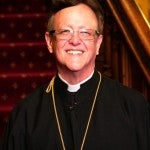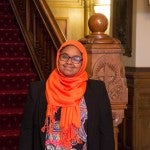Icons and Iconography: Islam and Orthodox Christianity
Part of Campus Ministry’s work, and the work of the Georgetown, is to not just create spaces for individual faith traditions to grow, but to grow the educational discourse and conversation; to challenge what we think we know about faiths and to probe deeper into their context and history. One such program organized by Campus Ministry this semester was “Icons and Iconography,” an educational look at how two faiths that share regions, and a long history, have each engaged with imagery in their theologies. I had the privilege to interview Muslim student participant, Khadija Mohamud, and the V. Rev. Constantine White, in a post-program conversation to try and encapsulate a fraction of the wonderful program. 
Father, Khadija, thank you so much for speaking with me today and for sharing your own reflections on this program.
Fr Constantine White (FC): Of course.
 Khadija Mohamud (KM): Yeah, my pleasure. I love these kinds of programs.
Khadija Mohamud (KM): Yeah, my pleasure. I love these kinds of programs.
Why do icons play such an important role in your faith tradition?
FC: We look at the icons as windows into heaven. They depict various events in the history of our salvation. For example, at all the major feasts there is a specific icon to help people understand the theological significance. The basis for being able to depict people as icons is because [we believe] that God was manifested physically in Jesus Christ and because of that manifestation we can depict him and others that had to do with our salvation as well.
KM: Physical depiction of people from important figures like prophets is something that in current times is highly controversial; even though in the time after the prophet’s death people did try to create pictures for historical reference. However, in modern-day there is so much controversy and I think it’s because of the different interpretations of hadiths (sayings of the prophet) that discuss certain restrictions on depicting creations that only God can create. There is a tension between what God can do versus what we can do in art.
Fr. Constantine, why was it so important to do this program; Orthodox and Muslim specifically?
FC: There is use of icons in the Catholic tradition, particularly in the Eastern-right, but the “theology of iconography” stems from the Eastern Church.
Khadija?
KM: Eastern European Muslim communities have taken the conceptual ideas and use of iconography in the Orthodox Church and incorporated it into the artwork inside mosques. Imam Hendi showed an example of a Mosque in Kosovo that some would consider very controversial because of the imagery inside, however this example highlights the diverse understandings of Islam within the Muslim world.
What did you find most interesting about the other tradition?
FC: I was surprised there was any use of iconography in Islam at all because I associate iconoclasm with Islam and Judaism. There was also a period of iconoclasm in the Eastern Orthodox Church. It was in-part due from influence from Islam and Judaism.
Imam Hendi spoke about the use of calligraphy in Islam as the way that Muslims have embraced artistic creation on the canvas and on the walls, can you speak about the importance of that?
KM: To Me? Well first off, it’s a very common in a Muslim household to have calligraphy with the prophets name or verses in the Qur’an. It’s seen as a very beautiful form of worship. It’s very abstract compared to modern day standard Arabic so its not something that you would really be able to pick up on the words necessary. The style is very special and unique and it varies within regions in the Muslim world. Calligraphy has experienced a giant revival in the last few years, and now with the political movements some artists use Arabic calligraphy to write expressions. You see it everywhere, almost like graffiti; calligraphy is becoming a way of speaking out in protest.
Fr., has Orthodox iconography evolved to have modern outlets of expression the way Khadija explained Caligraphy to have had?
FC: I don’t think so. Because in countries that are predominantly Orthodox it is considered a unique sacred form of “art.” We don’t even call it religious art or refer to the artists as “painters.” It is a spiritual endeavor. We would refer to it as Iconography, the writing of icons or images. They are used to help believers in their experience of worship. Particularly when the interior walls of churches are covered with icons, their presence goes along with the service to help the believer taste the Kingdom of Heaven.
Father Constantine, Khadija, thank you again for taking the time to speak to us about the program, and some major points. It’s powerful to see how such a singular issue can have such wide-spread impacts in a faith community.
Jeremy Koss, Communication and Outreach Coordinator interviewed Khadija Mohamud, SFS ’17, and V. Rev. Constantine White, Director for Orthodox Christian Life.
- Tagged
- Muslim
- Orthodox Christian